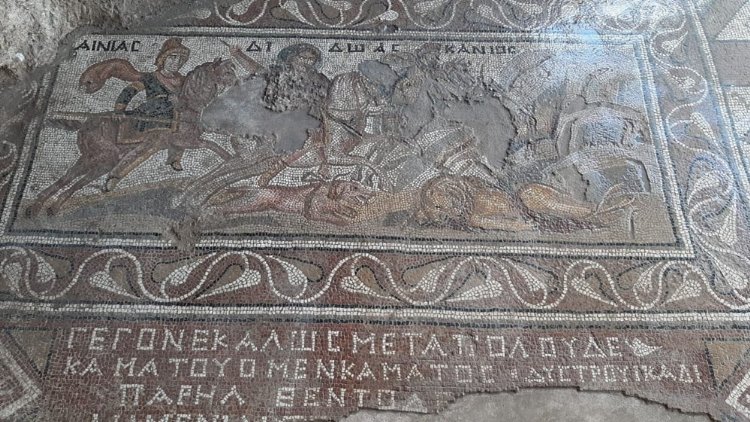
The mosaic of the Trojan War hero ‘Aeneas,’ with no parallel in the world, has been uncovered
During the excavation of the foundation of a construction site in the Kadirli district of Osmaniye, the mosaic of the Trojan War hero, also known as the ancestor of the Roman people, ‘Aeneas,’ was uncovered. The mosaic was found in the ruins of a Roman-era villa.
According to a news article from the IHA, the mosaic depicting the Trojan War hero “Aeneas,” whose name also appears in Homer’s epics “Iliad and Odyssey,” is said to have no parallel in the world.
In 2015, during the excavation of the foundation of a construction site, the remains of a Roman-era villa were discovered. In the excavation conducted by the Provincial Directorate of Culture and Tourism, a mosaic depicting the Trojan War hero “Aeneas,” mentioned in Homer’s “Iliad and Odyssey,” was brought to light.
After thorough examinations, it was determined that the mosaic found had no other example in the world. The mosaic is believed to have been created in the 1st and 2nd centuries AD, and it is noted that the mosaic area, thought to belong to a villa of that era, adorned the floor of the villa.
Researcher, historian, and writer Cezmi Yurtsever, who stated that there is no similar example in the world for the uncovered Aeneas mosaic, mentioned, “In 2015, news arrived that historical artifacts and mosaics were found on the floor of a building in the city center of Kadirli. Archaeologists arrived and conducted excavations. During these excavations, mosaic scenes were found on the floor of the building. In one scene, a warrior is depicted riding a horse, holding a spear, and accompanied by a woman, going for a lion hunt. The name of that woman is mentioned in inscriptions as Dido. The name of the hero is mentioned as Aeneas. This heroic warrior Aeneas was a significant figure who participated in the Trojan War. He was an important figure following the Trojan prince Hector. The scene of the Trojan War hero Aeneas battling a lion was found here.”

This was the city of Flaviapolis.
Continuing his explanation, Yurtsever stated, “This place was the ancient city of Flaviapolis built during Roman times. This mosaic was created here in the 3rd century AD. Having a mosaic depicting a hero from the Trojan War in the ancient city of Flaviapolis, just 1,500 years after the Trojan War during the Roman era, indicates the presence of a unique and magnificent work of art that has no equivalent in the world. If the excavations are completed and this place is developed for tourism, Kadirli and Osmaniye will come into the spotlight of world tourism. This is because the mosaic of the world’s most valuable Trojan War hero is found here.”
The mythological hero Aeneas.
Aeneas is a legendary Trojan hero in Greek and Roman mythology. According to the legend, Aeneas was a Trojan prince and the son of the goddess Aphrodite (Venus in Roman mythology).
During the Trojan War, Aeneas fought alongside the Trojan horses and was one of the few Trojan warriors who survived the fall of Troy. After the war, he led a group of Trojans on a long journey and eventually arrived in Italy, where he founded the city of Lavinium. Aeneas is most famously known as the protagonist of Virgil’s epic poem, the “Aeneid,” which narrates his journey and the founding of Rome.
Cover Photo IHA
You may also like
- A 1700-year-old statue of Pan unearthed during the excavations at Polyeuktos in İstanbul
- The granary was found in the ancient city of Sebaste, founded by the first Roman emperor Augustus
- Donalar Kale Kapı Rock Tomb or Donalar Rock Tomb
- Theater emerges as works continue in ancient city of Perinthos
- Urartian King Argishti’s bronze shield revealed the name of an unknown country
- The religious center of Lycia, the ancient city of Letoon
- Who were the Luwians?
- A new study brings a fresh perspective on the Anatolian origin of the Indo-European languages
- Perhaps the oldest thermal treatment center in the world, which has been in continuous use for 2000 years -Basilica Therma Roman Bath or King’s Daughter-
- The largest synagogue of the ancient world, located in the ancient city of Sardis, is being restored











Leave a Reply